Annual rate of home value growth slows as LVR takes effect
STRICLY EMBARGOED UNTIL 12 NOON NOVEMBER 1,
2016 Annual rate of home value growth slows as LVR takes
effect
The latest monthly QV House Price Index shows that nationwide residential property values for October have increased 12.7% over the past year, which is the slowest rate since May. Values rose by 3.3% over the past three months and are now 50.2% above the previous market peak of late 2007. When adjusted for inflation the nationwide annual increase drops slightly to 12.4% and values are now 27.4% above the 2007 peak. The average value nationwide is $622,309.
The Auckland market has increased 13.8% year on year which is the slowest rate since March 2015. Home Values in the Super City rose by 5.3% over the past three months and are now 91.3% higher than the previous peak of 2007. When adjusted for inflation values rose 13.6% over the past year and are 62.1% above the 2007 peak. The average value for the Auckland Region is $1,045,207.
The full set of QV House Price Index statistics for all New Zealand for October can be downloaded by clicking this link: QV House Price Index (HPI) for October 2016.
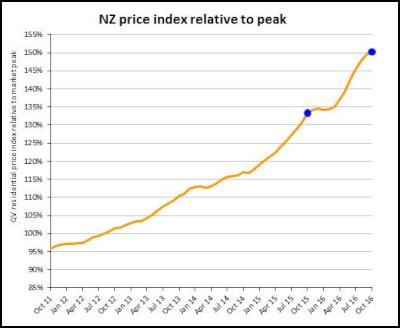
QV National Spokesperson Andrea Rush said, “The QV House Price Index is now showing a slight tick to the right which reflects an easing of 1.6% in the annual rate of growth over the past month as the latest round of LVR restrictions begin to take effect.”
“Sales volumes are down by around 12.0% on the same period last year and mortgage approval rates are also down.”
“Home values continue to rise faster in the Wellington Region than the Auckland Region, and the housing market in the Capital appears largely unaffected by the new LVR restrictions, particularly at the more affordable end of the market in areas such as the Hutt Valley, Porirua and the Kapiti Coast.
Auckland, Tauranga and Hamilton home values are continuing to rise, just at a slightly slower pace than they were prior to the new LVR measures being introduced in late July.”
“The Dunedin market also continues to see good levels of activity and demand, while investors are less active in the Christchurch market and home values there continue to show only moderate value growth.
“The new build market remains strong across the country as the new LVR restrictions for investors do not apply for new homes.”
“Less established investors appear to be having difficulty raising finance with the new 40% deposit requirement, while recent CoreLogic Buyer Classification Data shows that 34% of investors with five or more properties do not need to raise a mortgage so are not affected by the new LVR rules.”
“Those investors shut out of more expensive markets appear to be turning their sights to more affordable markets in relatively close proximity to North Island main centres such as the Western Bay of Plenty, Whangarei, Rotorua and the Waikato District and all of these areas continue to see very strong value growth.”

Auckland
Home values
across the Auckland region are still rising but for most
places at a slightly slower rate than prior to the new LVR
restrictions being announced in late July.
The former Auckland City Council central suburbs have increased by 12.0% over the past year and 3.9% over the past three months .The average value there is now $1,209,199.
Values in the former North Shore City suburbs also rose 13.5% year on year and a strong 5.2% over the past three months and the average value there is now $1,220,550.
Manukau suburbs were up by 15.6% year on year and a still strong 5.5% over the past three months, the average value there is now $906,128.
Waitakere City values were up by 13.5% year on year and are bucking the trend, accelerating by 7.1% over the past three months. The average value in the West is now $837,300.
QV Auckland General Manager, Jan O’Donoghue said, “We have seen a surge of listings in Auckland over the past month after a wet start to spring. However the LVR changes continue to have an impact in that we continue to see a lower level of activity and demand in the market.”
“Values continue to rise and there continues to be strength in the $1.5 million upper bracket of the market in particular.
“As well as the new build market which continues to see good value growth, particularly in new developments – where we are seeing as one property is sold in a development, the sale prices achieved tend to increase as more properties are sold in the development.
“Demand has eased back from previous highs at the low-end of the market now that there are not as many investors active in the Auckland market due to the new LVRs.
“It appears that new investors and ‘Mum and Dad’ investors are the ones most affected as they are reliant on higher loan to equity ratios, and so tend to be more affected by the LVR changes than well-established investors.”
“There are reports of investors’ having more difficulty raising the extra finance through banks, following the new LVR changes. There are still properties selling but it is not as easy as it was prior to the new changes coming into play.”
Hamilton
Home values across
Hamilton City have risen 25.0% year on year and 4.7% over
the past three months. The average value in the city is now
$537,388.
QV homevalue Hamilton Valuer, Stephen Hare said, “It appears there is still demand for residential properties in the Hamilton market from local buyers, first home buyers and out of town buyers relocating to Hamilton.
“However, the latest LVR restrictions have definitely had an impact in terms of reducing the level of investor demand and activity in the market.”
“We continue to see more properties being passed in at auction than we did in the first half of the year prior to the new LVR restrictions being announced.
“With an increasing number of properties are now more commonly tending to sell by negotiation after auctions rather than under the hammer.”
“Sections in lower value based localities are seeing an increase in demand. The latest LVR changes apply to existing homes only so new builds are becoming of interest to investors.”
“In the surrounding regions, the property market in Thames is experiencing similar demand to other townships in the Waikato region and this is driving values up in the town.”
“Auckland buyers are entering the Thames market for both affordable living and investment purposes. They are typically buying mid to high range properties ranging from $400,000 to $600,000 in value. Some are now commuting from Thames to Auckland.”
“Along the Coromandel Coast supply is unable to keep up with demand with the increase in buyer’s interest. Typically demand is coming from out-of-town buyers seeking holiday homes.”
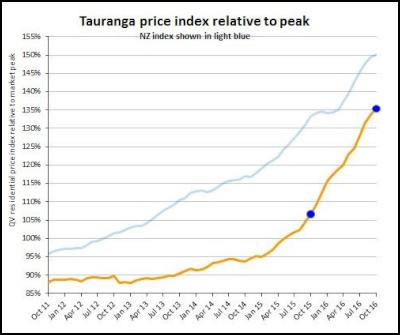
Tauranga
The
Tauranga market continues to rise, with home values in
Tauranga City up by 27.0% year on year and 5.9% over the
past three months. The average value in the city is now
$651,725. Western Bay of Plenty home values have risen a
huge 33.0% over the past year and 10.5% over the past three
months alone. The average value in the district is now
$596,782.
QV homevalue Tauranga, Registered Valuer, David Hume said, “There is still good enquiry for quality residential property around the Bay of Plenty and the housing market appears to have improved following the a slow period leading into spring, where there was an extended period of bad weather and the announcement of new LVR restrictions.”
“However the frenzy that was being witnessed earlier in the year has subsided to more normal levels of activity and demand with properties going to a two to three way multi-offer scenarios as opposed to a six to seven offers.”
“There are still a limited number of properties listed for sale on the market and there hasn’t been the usual strong spring surge in listings and this is also fuelling demand.”
“Recent figures show that rents have risen approximately 30% over the last two years.”
"It appears there is also is an increasing number of retirees from Auckland moving to the Bay of Plenty, effectively downsizing and freeing up equity for retirement.”
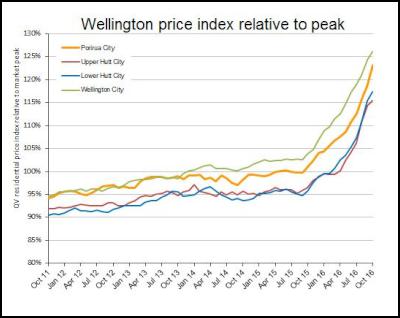
Wellington
The QV House Price Index for the wider
Wellington region shows home values rose 21.1% year on year
and 6.6% over the past three months and values are now 22.6%
higher than in the previous peak of 2007. The average value
across the wider region there is now $558,886.
Home values in Wellington City suburbs rose 21.3% year on year and 6.0% over the past three months. The average value there is now $671,387. Lower Hutt rose 22.6% year on year and 9.4% over the past three months while Upper Hutt values were up 19.6% year on year and 8.7% over the past three months; Porirua also rose 21.7% year on year and 9.3% over the past three months and the Kapiti Coast was up 18.5% year on year and 7.1% over the past three months.
QV homevalue General Manager, David Nagel said, “The Wellington housing market is still characterised by strong demand from buyers and investors and a shortage of supply of properties on the market. To date the usual annual seasonal surge in property listings has not eventuated.”
“At this stage the latest LVR restrictions do not appear to be affecting the market hugely, and there are plenty of local investors who are still active across the Wellington region.
“The Hutt Valley market continues to show strong value growth and this is primarily down to there being more affordable, entry-level properties in the Hutt Valley both for first home buyers and investors.”
“The Kapiti Coast market is also continuing to experience high demand as it develops well into a serious alternative for Wellingtonians. Particularly with new motorway and infrastructure development underway - which is hoped will stabilise and possibly reduce the commuting distance between Wellington and the Kapiti Coast.”
“The upper end of the market is not experiencing as much activity, demand and value growth as the low end of the market currently.”
“However, good quality, high end, central Wellington properties attract high interest when they come onto the market, because there isn’t many of them available, and they sell quickly.”
“We continue to see potential buyers who have missed out on multiple properties, becoming frustrated which can then fuel the market, as these buyers can resort to desperate measures and high offers to secure a property.”
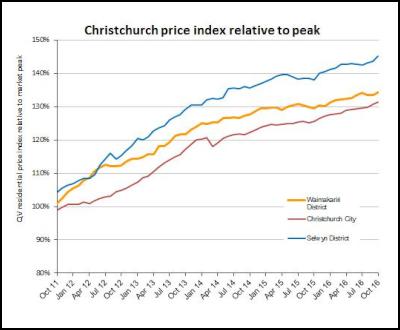
Christchurch
Home values in Christchurch City increased 4.7%
year on year and 1.3% over the past three months and they
are now 31.4% higher than the previous peak of 2007. The
average value in the city is now just shy of half a million
dollars at $498,425. Values in the Christchurch Hills
suburbs rose the most over the past year, up 7.1% since
October 2015.
“QV homevalue Christchurch, Registered Valuer Damian Kennedy said, “After a quiet winter and a slow start to spring over the past month we’ve seen a burst of new listings coming onto the market and there are noticeably more open homes around the city.
“There is good demand for properties in areas zoned for popular schools for example Fendalton, Riccarton, Merivale, and Strowan, and properties in these areas are popular and are selling well.”
“Properties outside popular school zones are receiving less interest from buyers, and in areas where buyer interest isn’t as high, we are seeing a shift from auction as the preferred method of sale and to price marketing as the more popular way to sell.”
“This is usually an indication of less demand and there has been a decrease in demand from investors in the market and it’s not clear whether this is a result of the new loan to value requirements or the lack of recent growth in the Christchurch housing market.”
“Some agents are suggesting first home buyers are preferring the move in and enjoy renovated dwellings whilst those investors still active in the market are favouring the ‘do uppers’ with scope to add value through improvements to the dwellings.”
“The new build market is still performing well, and this is likely to be because both first home buyers and investors can purchase a new build more easily than an existing property because the LVR deposit rules are not as restrictive for new builds, and the KiwiSaver HomeStart grant contribution increases also.”
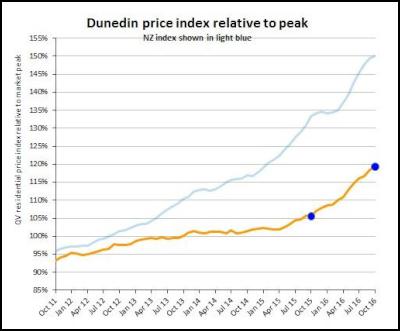
Dunedin
Dunedin city
home values have risen 13.0% year on year and 2.9% over the
past three months. The average value in the city is now
$341,566. Suburbs in Dunedin-South saw values rise the most
over the past year up, 14.3% since October 2015.
QV homevalue Dunedin Registered Valuer, Duncan Jack said, “There has been no apparent let up in buyer demand and value growth in the Dunedin residential property market since the introduction of the new LVR restrictions in late July requiring a 40% deposit for those purchasing investment property.”
“Strong demand for property is continuing across all the value ranges in the market.”
“We continue to see very strong competition for properties within the $200,000 to $300,000 price range which continuing to drive sales prices higher.”
“Properties within this range are selling very quickly and there are reports of high numbers at open homes and multiple offer scenarios now being commonplace.”
“Investors are competing with first home buyers for properties in this bracket of the market.”
“For the higher value range properties, the market is less buoyant, with less activity and value growth however there is still solid demand within this sector also from local buyers and for an increasing number of people relocating to Dunedin from other parts of the country.”
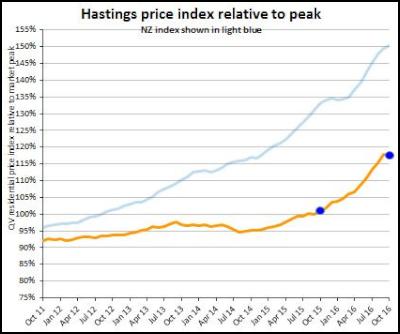
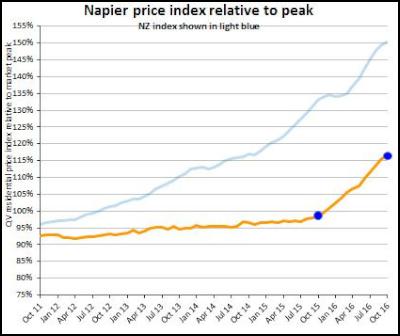
Hawkes
Bay
Napier home values continued to see strong
growth rising 18.1% year on year and 4.3% over the past
three months. The average value in the city is now nearly
topping $400,000 and is sitting at $396,000. Hastings values
16.3% year on year and 3.6% over the past three months. The
average value there is now $366,083.
QV homevalue Hawkes Bay, Registered Valuer Bevan Pickett said, “The Hawkes Bay residential property market is still booming and remains in a strong state with most having an optimistic view on it continuing for the short term at least.”
“So far the new LVR restrictions for investors do not seem to have had much of an impact on demand here.”
“There remains a shortage of supply of good quality listings on the market and the fact that supply can’t keep up with demand from buyers is continuing to fuel the market.”
“Properties are generally selling under tender and auction methods of sale, in many cases this is fuelling the situation allowing the highest achievable price to be reached.”
“The bulk of volume and demand remains in the entry level with investors and first-home buyers competing strongly.”
“Buyers from out of the district continue to have a clear presence in the market however local purchasers appear to be most prominent buyer group.”
“Many homeowners have perceived it as a good time to sell and re-enter the market later after it has slowed, however they are now getting left behind by the market and face getting back onto the ladder with limited expensive options available to them.”
“Investors and developers buying properties to do-up and resell quickly are also a common feature of the market.”
“There remains a shortage of rental properties available which has added to the wider appetite for housing in the market.”
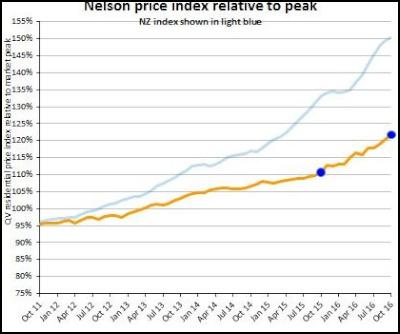
Nelson
Nelson home
values have increased by 13.8% year on year and 4.1% over
the past three months. The average value in the city is now
$484,019. Values in the city are now 26.4% above the
previous peak of 2007. The Tasman District also increased by
12.8% over the past year and 6.1% over the past three months
and the average value in the district is now $485,666.
Values in the district are now 20.9% above the previous peak
of 2007
QV homevalue Nelson Registered Valuer Craig Russell said, “The tighter loan to value restrictions for investors has seen some of the impetus taken out of the market with demand easing slightly over the previous month.”
“Current listing levels have remained
steady in Tasman and have not yet seen the usual spring
surge while listings levels in Nelson are only up slightly
in Nelson on last month.”
“The lower to median price
bracket remains active with first home buyers or cashed up
investors looking to take some of the slack left by
investors affected by recent LVR changes which require them
to have a 40% deposit for an existing property rather than
20% needed previously.”
“New houses remain an attractive option given the lower deposit required by both owner occupiers and investors.”
“Low maintenance stand-alone townhouses are obtaining premium prices in well located areas within walking distance to local shops and parks and may be appealing to retirees looking for low maintenance housing options.”
Other
Provincial centres
In the North Island, all
areas saw double digit value growth over past year since
October 2015, with none showing a decrease. The strongest
annual growth was recorded in the Kawerau District where
values rose 49.3%, however they are coming off a very low
base there and the area still has one of the lowest average
values of anywhere in the North Island at $151,957 and
values there are still 4.6% below the previous peak of
2007.
In the South Island, annual value growth in the provincial centres has been much lower with most areas seeing single digit value growth with the exception of Queenstown Lakes District (up 29.8%), Central Otago (up 21.5%), the MacKenzie District (up 18.6%), Tasman (up 12.8%), Nelson (up 13.8%) and Marlborough (up 14.4%). The only areas to see a decrease in values over the past year were the West Coast Districts of Buller and Grey; the Hurunui District in North Canterbury and the South-Western suburbs of Christchurch.
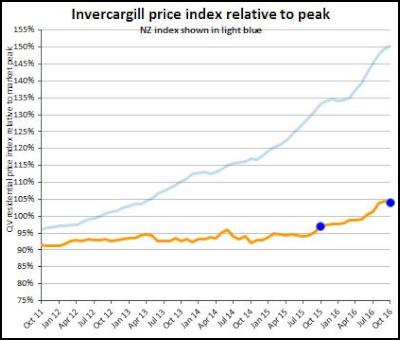
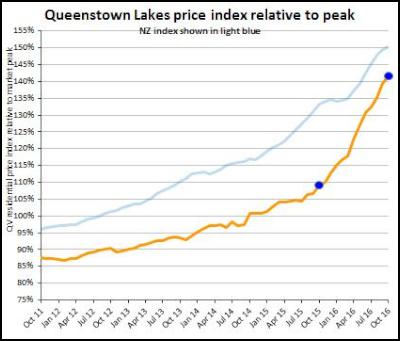


 Property Council New Zealand: Hiwa Recreation Centre Takes Top Award At 2025 Property Industry Awards
Property Council New Zealand: Hiwa Recreation Centre Takes Top Award At 2025 Property Industry Awards Great Journeys New Zealand: Scenic Plus Winter Menu Launched
Great Journeys New Zealand: Scenic Plus Winter Menu Launched Tourism New Zealand: Tourism New Zealand Invites The World To Find Their 100% Pure New Zealand In New Global Campaign
Tourism New Zealand: Tourism New Zealand Invites The World To Find Their 100% Pure New Zealand In New Global Campaign Bill Bennett: Comcom warns 2degrees over satellite marketing
Bill Bennett: Comcom warns 2degrees over satellite marketing Transpower: Major Electricity Development For Western Bay Of Plenty A Step Closer
Transpower: Major Electricity Development For Western Bay Of Plenty A Step Closer Alcohol Beverages Council: Turning The Tide - New Zealanders Unite To Curb Harmful Drinking
Alcohol Beverages Council: Turning The Tide - New Zealanders Unite To Curb Harmful Drinking


